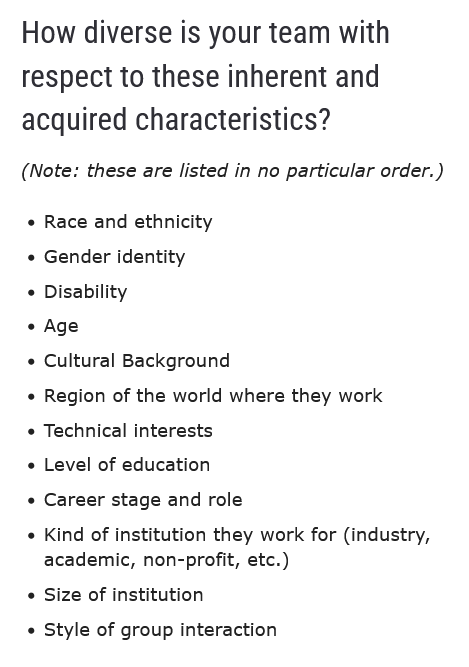Based on their commitment to diversity, equity and inclusion in computing, the Association of Computing Machinery has put forward a list of considerations to forming diverse teams. This list includes inherent characteristics such as race and ethnicity, gender identity and disability, as well as acquired characteristics, e.g. education, career stage and style of group interaction. This list gives researchers something to hold onto when thinking about diversity in their work group.

But is checking certain characteristics off a list a sufficient way of fostering diversity in computing?
In a recent discussion among members of our work group at the department of Participatory IT Design, we delved into the multifaceted nature of diversity in computing, asking ourselves and each other what diversity means to us. Here, I share our experiences and viewpoints, exploring how diversity affects our research, work practices, and the way we approach the field of computer science.
Working with Diversity in Informatics
Looking back on over twenty years of research and teaching experience in informatics faculties at various German universities, Claude reflected on the manifold challenges that working with diversity in informatics entails. She highlighted her article in which she stresses the need for a cultural shift within informatics moving beyond token initiatives to genuine integration of diverse methodologies and disciplinary backgrounds. This shift is crucial, bringing in matters of care into the discipline of computer science and calling for resources and structural integration of diversity in the culture and structure of informatics departments.
Diversity in Teaching
Lisa shared how their background in sociology and gender studies influenced their approach to teaching computer science. Lisa considers matters of diversity in a more practical way by making use of a diverse set of methods, didactics and considering student’s varying needs and backgrounds, aiming for a discipline that is accessible to and for all. They also criticized how approaches to foster diversity are often based on certain categories that people in general, and especially those from marginalized and underrepresented communities must fit into to benefit from inclusive practices. For example, while German initiatives to increase participation in computer science exist at plenty, multi-dimensional and intersectional approaches are often missing. Many initiatives and programs still take binary approaches that excludes trans* and non-binary perspectives, reproduce gendered stereotypes and view groups and communities as homogenous without being aware of varying intrisic privileges and challenges.
Disciplinary Diversity
Our discussion emphasized the importance of disciplinary diversity in both our backgrounds and project work. We explored how bringing together diverse perspectives benefits the discipline of computer sciences as well as disciplines that should be closely connected to it.
Lea discussed how non-IT backgrounds contribute viewpoints that enrich our research by blurring boundaries in disciplinary and methodological diversity. They also emphasize how the entanglement of different perspectives of social sciences, humanities and computer science is needed to deal with technological innovation in a meaningful and thorough manner in today’s society. While Viktoria’s background is more technical, she emphasized how humanities or social perspectives as well as creative approaches to design were always included in her studies, research and work. For example, the project Fairdienste was interdisciplinary and took into account diverse perspectives on fairness in computing, a topic that could not have been investigated from a non-diversity oriented perspective.
Diversity in Perspectives & Knowledges
Goda put forward the importance of the analysis of deeper implications of technologies, as well as conditions out of which they emerge. Looking at the socio-technical effects and conditions entails including the perspectives that computing is situated in, a transdisciplinary approach and methodological openness. This means understanding the design of technology not as a design of objects, but of relations and new socio-technical settings. For Goda, approaching diversity encompasses alternative knowledges and specifically intersectional perspectives by focusing on power relations and actively centering marginalized perspectives, either in terms of discipline or in terms of people.
Where Does Computing Belong?
The discussion concluded with a reflection on the disciplinary identity of computing. Claude mentioned the ongoing debate about whether computing should be considered a science, engineering, or perhaps even a social science. This debate underscores the diversity within the field itself and highlights the importance of interdisciplinary approaches in pushing the boundaries of what computing can be.
Conclusion
Diversity in computing extends beyond the inclusion of different racial, gender, and cultural backgrounds. It encompasses a wide range of academic disciplines, professional experiences, and personal perspectives. In that, diversity is at the forefront of PIT’s research, work and teaching, with ongoing and dynamic exploration of the concept and its principles. Taking an active approach to be inclusive and considering (disciplinary) perspectives that might be marginalized and invisibilized means “doing diversity”, because diversity is not something that can be checked off a list, but rather an ongoing practice.
By reflecting on our discussions and sharing these insights, we hope to inspire others in the field to reflect on their practices and to take active steps towards doing diversity in their own research and work.
Our team’s recommended further resources on this topic:
- How to design with and for marginalized communities not simply towards better use but towards justice: Costanza-Chock (2020), Design Justice, MIT Press.
- Introduction of aspects of gender & diversity into the practical development of technology, a model developed by members of our team together with researchers from the University of Bremen: GERD-model
- Example for the use of diversity as a design metric for online platforms, a thorough discussion of the implementation of diversity by design balancing aspects of inclusion and protection of marginalized groups: Helm et al. (2022), Diversity by Design?: Balancing the Inclusion and Protection of Users in an Online Social Platform, AIES ’22: Proceedings of the 2022 AAAI/ACM Conference on AI, Ethics, and Society.
- Elaboration of how participation can be offered in more diverse ways (in this case specifically for children), with participatory design as a means to include diversity in systems design: Falk et al. (2024), Designing Diverse Pathways for Participation, In: Proceedings of the CHI Conference on Human Factors in Computing Systems (CHI ’24).



